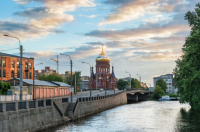This inappropriately-named establishment is hardly bigger than the average cupboard, but somehow manages to mount a range of visually adventurous work, most notably that of highly talented director and creator Yana Tumina. Her devised, largely wordless play Barrier examines the relationship between a composer and a fragile young woman named Dorothy who may be fan, stalker, housekeeper, lover or muse — or all at once, we’re never really sure. She breaks free from some type of institution — perhaps a lunatic asylum — to inspire him to continue living to the full and writing music.
Everything is lovingly conjured by Tumina using meticulously crafted, lo-fi imagery: notes dancing above the stage; a forest of swinging metronomes; courtship conducted *inside* the guts of an old piano; a cardboard cut-out puppet-ballet; desks transformed into angel-wings to carry the protagonist away in the end.
There’s more visual magic from Tumina in Karabel Ekziuperi or The Ship of Exupéry — which explores the life and creativity of Antoine de Saint-Exupéry, author of the Little Prince. It all begins with a cascade of ball-bearings flooding the stage and continues with the author working *vertically* at a typewriter bolted to the wall or levitating the pages of his manuscripts thanks to a fan sunk into the floor. Both shows are utterly enchanting; demonstrating what can be achieved without the usual "literary' crutches of plot and dialogue.
Another group that goes much further in demonstrating what can be achieved through pure, distilled theatricality is AKHE.

Founded twenty years ago by two post-modern clowns named Maksim Isaev and Pavel Semtchenko, AKHE — a russification of the English word AXE — has revolutionized performance in St. Petersburg, creating an entirely new genre that they call "Engineering Theater.' Here, the onstage processes — physical, chemical, visual, mechanical — are the dominating factors. No-one ever "acts' in an AKHE show — they just undertake a series of weird and wonderful, often only vaguely connected tasks.
Their first pieces- Belaya Kabina or White Cabin, premiered in 1996 and Pukh I Prakh or Dust and Fluff seen in 1999 — explored life, death and the tortured relations between the sexes through a montage of searing imagery: a performer slashing bulging bags of water tied around body with a razor; a miniature storm on a tabletop, complete with flashes of 2D lightening; the naked, deathly-pale back of an actress as she bathes herself with a jug of milk; an actor reading a flaming newspaper; a burning planet revolving slowly around the stage.
These shows established AKHE abroad as a force in new Russian theater, but has been at home, here in St. Petersburg, where the company has always been most creative and productive. Last year, they took over the second stage of BDT for a series of performances called Mezhdu Dvyumy or Between the Two of Us, based on the Tibetan Book of the Dead. This included some astonishing scenes: the real-time construction onstage of a gigantic musical instrument — like an enormous Aolean Harp — made from actual-size coffins, a very long piece of guitar string and a swinging pendulum. There was also an onstage explosion that — perhaps unintentionally — covered audience members in a fine layer of dust; an impromptu punk-metal concert; a spinning, time-travel cube that carried the sole remaining performer away in the final part, while simultaneously "live-stream' broadcasting from inside via iPhone. As with all of AKHE’s work, mere descriptions can only go so far in explaining the sheer visceral impact of the performance; to fully understand the experience, you had to be there, sitting in the centre of the storm being bombarded by madness and chaos and noise and theatrical energy!
Even more astonishing was Shchedrin, performed over six dazzling evenings on Yelagin Island last Autumn, adapted from the novel Tales of the City by Russian satirist Mikhail Saltykov-Shchedrin. Again it was all created through overlapping scenes and images: a figure in an asbestos trench-coat engulfed in flames, a governor diving into a vat of fire; an actor with his gigantic head swathed in bubble-wrap and a femme fatale barbequing a hog’s head before — and again you had to be here to fully understand this — raising it like a flag up a flagpole.

Shchedrin, however, did also have a very concrete foundation of meaning — the story of 6 corrupt governors and their egotistical posturing and hypocrisy. Every evening a different performer passed the mantle of gubernatorial power — a scarlet coat — on to the next. Each candidate seemed ever more debauched and compromised. At the beginning of the whole process, the performers built the wooden skeleton of a city from boards and planks only to symbolically destroy it all in the end. By any measure, it was an extraordinarily impressive piece of theater, made more remarkable by the fact that these astonishing shows were seen only by a couple of hundred devotees in a windswept corner of a St. Petersburg Park.
To top it all, AKHE are ridiculously prolific. In the past year, they have also staged Cabinet of Curiosities, also on Yelagin, and Pene Dna or Froth on the Daydream, an open-air adaptation of the novel by French writer Boris Vian, which featured a massive foam machine and a bride with wedding dress in flames. To keep track of the company’s abundant output requires constant monitoring of their website: www.akhe.ru.
There are also a number of other spots to watch for new, progressive theater, most notably the excellent Erarta Centre on Vasilyevsky Island Island. And the big traditional institutions have also opened smaller venues for experimental work: as well as the second stage in the attic of BDT, there is also a second space at the Alexandrinsky, where it’s possible to find everything from concerts of "new' music to multimedia productions to the latest international modern dance. There have even been advances at the Mariinsky, where — in addition to building one of the most impressively modern Opera Houses in Europe with his Mariinsky II — Valery Gergiev has freshened up the repertoire with excellent contemporary productions such as Semyon Kotko, Prokofiev’s Soviet Opera set in a Ukrainian post-war wasteland, The Nose, Shostakovich's deranged operatic pantomime based on Gogol’s surreal story, as well as a sharp, elegant production of Verdi’s Macbeth by English producer David McVicar.
Of course, this kind of work is still in a very tiny minority in comparison to the vast classical monolith that is theater and culture in general in St. Petersburg. For every Nose — or, to be more precise, *missing* Nose — there are ten traditional Prince Igors, Evgeny Onegins and Sadkos all extravagantly swathed in painted backdrops and flouncy costumes. The majority of audience members — moreso in Russia than elsewhere — have a natural distrust towards anything even vaguely experimental and crave clear and pristine meaning, untainted by gimmicks or distractions.
But it must be remembered that even the most established of classics were controversial once — Mozart was seen in his day as radical. It’s important to safeguard the classics, of course, but equally important that new work is encouraged. For three centuries, this vital and vibrant city has been at the forefront of creating avant-garde new performances and exporting them around the world. Balanchine invented modern dance here. The iconic director Vsevolod Mayerhold mounted some of his earliest theatrical experiments here. And then, at the beginning of the 20th Century, there was the scandal created by the Sergei Diagalev and the Ballets Russes, first in St Petersburg and later in Paris with pieces now widely accepted as "classic.'
St. Petersburg has always been a city synonymous with "the shock of the New.' Long may it continue!
Photo credit: gazeta.spb.ru, all.culture.ru, life.mosmetod.ru



